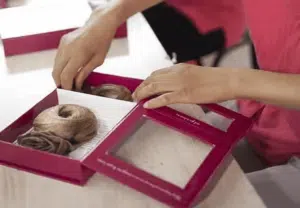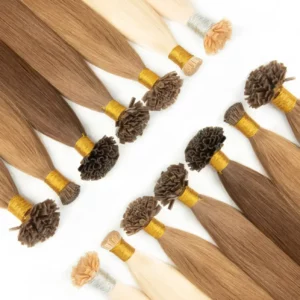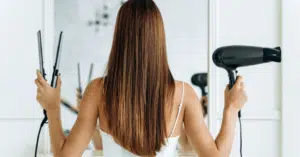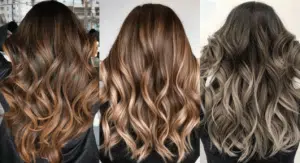I know if your clients ask for fast volume and length,the confusion may between clip-in and tape-in slows decisions. This guide removes guesswork so your team can recommend with confidence.
Clip-in extensions are temporary and DIY-friendly; tape-in extensions are semi-permanent and salon-installed. Clip-ins suit occasional wear and zero commitment; tape-ins suit daily wear with pro application, longer wear time, and cleaner blends. Choose by hair type, lifestyle, budget, and service goals.
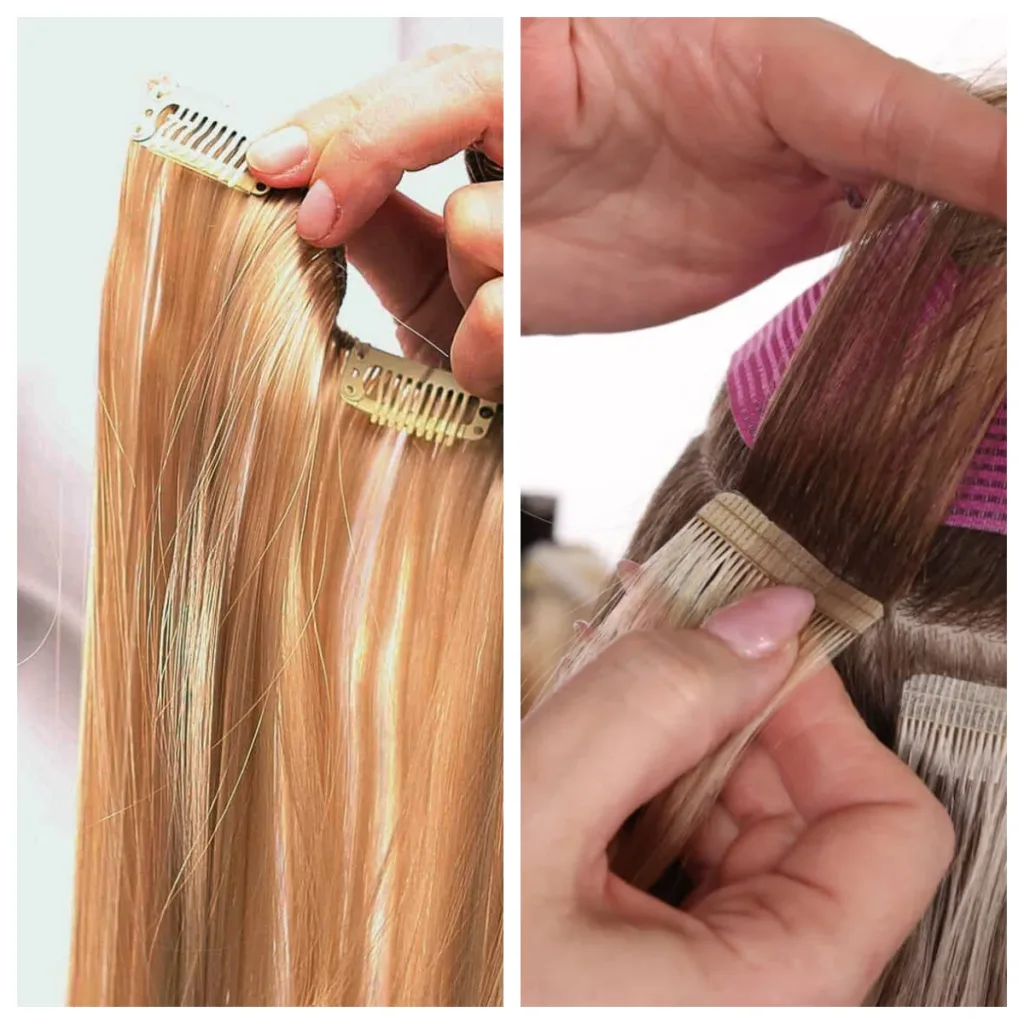
Here is a structured comparison designed for salon owners, wholesalers, and professional stylists. You will see pros, cons, installation SOPs, cost logic, staffing time, and aftercare. Use it to brief teams and standardize consultations.
The pros and cons of clip-in hair extensions?
Clip-ins deliver instant changes with no adhesive. They remove in minutes at home. They fit retail, e-commerce, and entry clients who want flexibility and control.
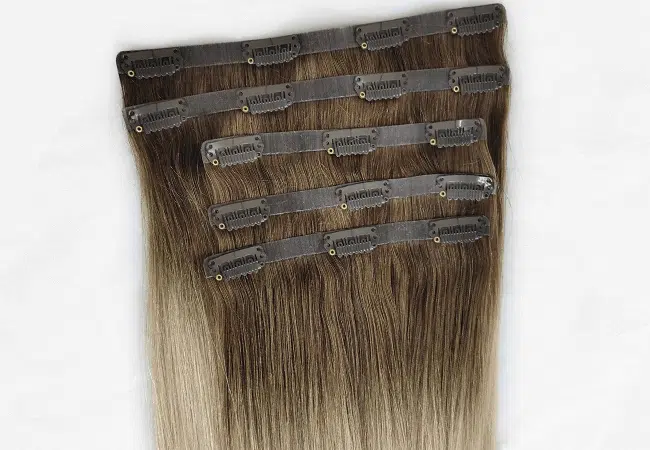
Clip-ins are temporary hair weaves designed with pressure-sensitive clips sewn onto hair wefts. A full set usually includes multiple widths for layered placement. The pieces attach under natural sections near the scalp and can be installed and removed daily. Because the system uses clips—not glue or heat—there is no chemical exposure during use. Clip-ins work well for events, travel, photoshoots, and clients who prefer not to visit the salon frequently. Quality matters: full cuticle, single-donor human hair gives a natural fall, longer life, and better heat styling compared to low-grade options. For salons and wholesalers, clip-ins are an important retail SKU that expands revenue beyond in-chair services.
Pros and Cons Table
| Factor | Pros | Cons |
|---|---|---|
| Commitment | Put in and remove anytime | Not ideal for sleeping or sports |
| Scalability | Retail-friendly; no chair time | Limited upsell on installation |
| Hair Safety | No adhesive on natural hair | Repeated rough clipping can stress fragile roots |
| Look | Fast volume/length boost | Less seamless than tape-ins on very fine hair |
| Cost | Lower entry price | Short daily wear; not “set-and-forget” |
How to Install Clip-Ins (Pro Retail Tutorial, clear and concise)
- Prep: advise client to start with clean, fully dry hair. Lightly smooth with a brush.
- Map: show a simple plan—nape (3-clip), mid (4-clip), crown (5-clip), and sides (2-clip).
- Section: create horizontal partings; tease a tiny anchor line only if needed.
- Place: snap clips open, set on the anchor, then snap closed firmly.
- Blend: curl or straighten with heat protection. Brush ends to merge lines.
- Remove: open clips gently from ends toward the center, never rip. Store flat.
The pros and cons of tape extensions?
Clients want everyday wear with clean, invisible blends.Tape-ins create a thin, flexible bond that lies flat. They look natural at the root. They require professional installation and maintenance.
Tape-in extensions are semi-permanent hair weaves with adhesive tops. A stylist sandwiches a thin section of client hair between two pre-taped pieces (or uses single-sided tape for finer hair). This produces a flat, discreet base that moves with the head. With full cuticle human hair, the sets can be re-taped and reused multiple cycles, keeping long-term cost in control. Tape-ins thrive in salon programs that emphasize routine move-ups, color maintenance, and photo-ready finishes. Correct solvent-based removal is essential to protect the client’s natural hair and keep the extension hair clean for re-taping.

Pros and Cons Table
| Factor | Pros | Cons |
|---|---|---|
| Aesthetics | Very flat, natural root | Requires pro application and removal |
| Daily Wear | Sleep- and gym-friendly | Oil near bonds weakens adhesive |
| Speed | Fast full-head installs | Move-ups every 6–10 weeks |
| Reuse | Re-tape and reinstall | Adhesive supplies and SOP needed |
| Upsell | Color blending and packages | Schedule discipline required |
Tape-In Installation SOP (Chair-Ready Detail)
- Consultation: assess density, oil production, lifestyle, and goals; agree grams and rows.
- Prep: clarify shampoo; 100% dry; no conditioner near roots.
- Section: clean, parallel lines; 1–1.5 cm from scalp; avoid tension points.
- Placement: install with even pressure; sandwich method or single-sided for fine hair.
- Spacing: keep uniform gaps; avoid overlapping angles at hairline and crown swirl.
- Seal: use a pressing tool or warm (brand-allowed) method for secure bond.
- Finish: blend lengths; educate client on washing, brushing, and product zones.
- Move-Up: book 6–10 weeks; solvent remove, cleanse, dry, re-tape, reinstall.
Which is better, clip-in or tape-in hair extensions?
Different clients need different systems.
Clip-ins are best for occasional use, zero-commitment styling, and DIY control. Tape-ins are best for daily, seamless wear, salon-managed care, and long-term programs.
Decision Matrix (Use in Consults and Sales Calls)
| Client Scenario | Recommend | Why |
|---|---|---|
| Event hair, travel, zero commitment | Clip-in | Fast, affordable, DIY on/off |
| Daily seamless wear, fine hair | Tape-in | Flatter base, natural movement |
| Gym, sleep, busy schedule | Tape-in | Set-and-forget with move-ups |
| Budget entry, e-commerce | Clip-in | Retail SKU, no salon time |
| Long-term color program | Tape-in | Blends and re-tapes for seasons |
| Sensitive to adhesives | Clip-in | No tape on natural hair |
Longevity, Maintenance, and Total Cost of Ownership?
Your recommendation should cover life cycle, reusability, and real costs.Clients trust clear timelines, re-tape math, and warranty-like care rules. Teams need scripts that set expectations and reduce support tickets.
Longevity depends on hair quality, installation discipline, and client care. With full cuticle, single-donor human hair, many clients enjoy 1–2 years of strand life under proper care, with multiple re-tape or reuse cycles. Clip-ins last by wear count and handling: careful clipping, soft storage, and heat protection preserve fibers. Tape-ins last by cycle: correct removal keeps adhesive and cuticles clean, which preserves reusability. Share a truthful cost view: clip-ins have a lower up-front price but can be replaced if daily-worn; tape-ins have service costs but amortize via re-tapes. Provide a simple aftercare card so clients avoid oils, high heat at bonds, and rough brushing.
Quick Economics Table
| System | Up-Front Cost | Ongoing Cost | Reuse Potential | Notes |
|---|---|---|---|---|
| Clip-in | Lower | Minimal | High if used occasionally | Great for retail revenue |
| Tape-in | Higher + service | Move-up every 6–10 weeks | High with re-taping | Predictable salon program |

Hair Health and Risk Management?
Clients keep loyalty when hair stays healthy.You reduce issues with right method, right grams, clean removals, and simple home routines. Uplift education beats refunds.
Risk grows when tension is high, sections are oily, or clients skip move-ups. Clip-ins can stress roots if clipped on fragile areas or yanked out. Teach clients to place on sturdy sections and to open clips fully before removal. Tape-ins can slip when oils or conditioners touch bonds. Train clients to keep leave-ins mid-length to ends. Removal must use approved solvents; never peel. For very fine hair, consider single-sided tape, lighter grams, or a hybrid plan (mix of tape and a few clip pieces for event days). Document a maintenance calendar at install to make move-ups non-negotiable.
Risk Control Checklist (Salon SOP)
- Map grams to density; avoid overweight rows.
- Keep 1–1.5 cm from scalp; no cross-tension at swirls.
- Solvent-only removal; thorough cleanse before re-taping.
- Brush from ends to roots; sleep in a loose braid; silk pillowcase.
- Heat protect every time; avoid heat near bonds.
- Book next appointment before leaving the chair.
Operations: Staffing Time, SKUs, and Client Education?
Operations make or break margins.Set clear service times, stock the right SKUs, and give clients card-sized aftercare. Your rebook rate and reviews will rise.
Clip-ins need no chair time; they do need retail coaching, color ladders, and quick try-on mirrors. Tape-ins need chair blocks, adhesive inventory, removers, tapes, pressing tools, and blending shears. Track install duration by stylist level to price accurately. For wholesale and brand partners, bundle education assets: quick-start videos, printable care cards, shade wheels, and gram calculators. Keep a small risk pool for warranty swaps to protect the relationship and speed resolutions.
Ops Snapshot
| Item | Clip-In Program | Tape-In Program |
|---|---|---|
| Revenue Mode | Retail + upsell styling | Service + re-tape cycles |
| Time | 0 chair time | 60–150 min install; 45–90 min move-up |
| Inventory | Sets by shade/length | Hair + tapes + removers |
| Education | DIY placement + storage | Full SOP + care cards |
Aftercare and Client Scripts?
Your script should be short, repeatable, and clear.Consistent language reduces callbacks and protects results.
Clip-In Script (handout-ready)
- Brush ends-to-roots before clipping in or out.
- Place clips on sturdy sections; avoid hairline baby hairs.
- Store flat; avoid sleeping in clip-ins.
- Use heat protectant; moderate temperatures.
Tape-In Script (handout-ready)
- Wash roots gently; keep oils mid-length to ends.
- Dry the bond area thoroughly after workouts or showers.
- Brush with a soft tool; support bonds with your hand.
- Book move-ups on schedule; solvent removal only.

My opinion
U recommend both systems in a balanced menu. Clip-ins expand retail and content creation; tape-ins anchor daily-wear services and stable rebooking. For fine hair and “invisible” needs, choose tape-ins with smart placement and single-sided options. For event-heavy clients or very budget-sensitive buyers, keep premium full cuticle clip-in sets in core shades. This barbell strategy raises cash flow and client satisfaction.
FAQ
Do tape-ins damage hair more than clip-ins?
Neither should cause damage when installed and removed correctly. Damage comes from tension, poor maintenance, and delayed move-ups. Educate and schedule.
How often should tape-ins be moved up?
Every 6–10 weeks depending on growth, oil production, and lifestyle. Set the window at consultation and pre-book the next visit.
Can clients sleep in clip-ins?
U advise against it. Remove clip-ins before sleep to protect roots and clips. Tape-ins are designed for sleeping when installed properly.
Which blends better on very fine hair?
Tape-ins usually blend better because the base is flatter and more flexible. Use single-sided tape options and light grams to protect hair.
What hair quality should U stock?
Full cuticle, single-donor human hair. It stays soft longer, styles better, and supports multiple reuse cycles, which protects client satisfaction.
What’s the fastest full-head service?
Tape-ins under a trained stylist are fast and consistent. Time varies by density, grams, and stylist level.
Conclusion
Choose clip-ins for zero-commitment, event styling, and retail. Choose tape-ins for daily seamless wear and reliable rebooking. Map choice to hair density, lifestyle, budget, and service plan to win long-term loyalty.
Hibiscus Hair Manufacturer has been dedicated to producing high-quality hair extensions for 25 years and is a recognized leader in the industry. If you are interested in finding a reliable hair extensions supplier and wholesale for your brand, please visit our website for more information:
HOME

